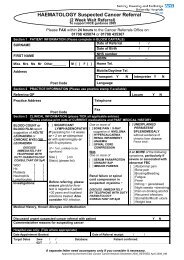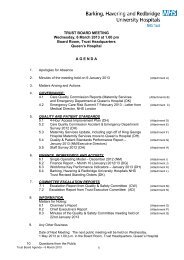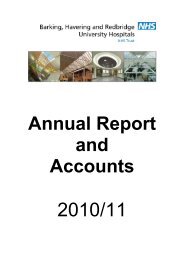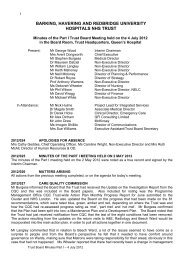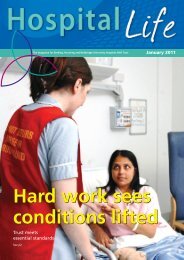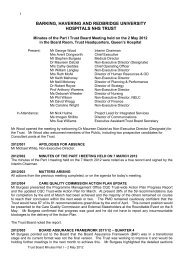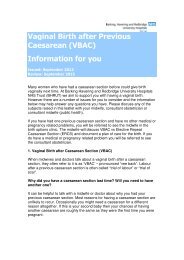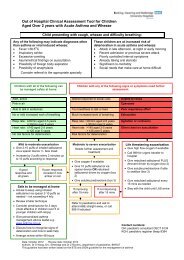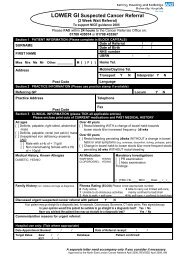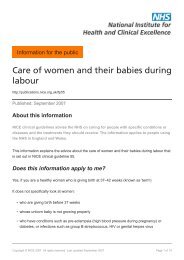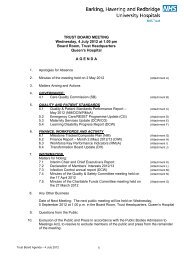BHRUT annual report 2009 - Barking Havering and Redbridge ...
BHRUT annual report 2009 - Barking Havering and Redbridge ...
BHRUT annual report 2009 - Barking Havering and Redbridge ...
You also want an ePaper? Increase the reach of your titles
YUMPU automatically turns print PDFs into web optimized ePapers that Google loves.
Annual Report & Accounts <strong>2009</strong>-2010<br />
57<br />
10.3 Staff sickness absence<br />
<strong>2009</strong>/10<br />
Number<br />
Total days lost 81,514<br />
Total staff years 4,853<br />
Average working days lost 16.80<br />
Total staff employed in period (headcount) 6,491<br />
Total staff employed in period with no absence (headcount) 2,709<br />
Percentage staff with no sick leave 41.7%<br />
10.4 Management costs<br />
<strong>2009</strong>/10 2008/09<br />
£000 £000<br />
Management costs 21,030 20,095<br />
Income 397,456 378,400<br />
11. Pension costs<br />
Past <strong>and</strong> present employees are covered by the<br />
provisions of the NHS Pensions Scheme. Details of the<br />
benefits payable under these provisions can be found<br />
on the NHS Pensions website at<br />
www.nhsbsa.nhs.uk/pensions.<br />
The scheme is an unfunded, defined benefit scheme<br />
that covers NHS employers, General Practices <strong>and</strong><br />
other bodies, allowed under the direction of the<br />
Secretary of State, in Engl<strong>and</strong> <strong>and</strong> Wales. The scheme<br />
is not designed to be run in a way that would enable<br />
NHS bodies to identify their share of the underlying<br />
scheme assets <strong>and</strong> liabilities. Therefore, the scheme is<br />
accounted for as if it were a defined contribution<br />
scheme: the cost to the NHS Body of participating in<br />
the scheme is taken as equal to the contributions<br />
payable to the scheme for the accounting period.<br />
The scheme is subject to a full actuarial valuation<br />
every four years (until 2004, every five years) <strong>and</strong> an<br />
accounting valuation every year. An outline of these<br />
follows:<br />
a) Full actuarial (funding) valuation<br />
The purpose of this valuation is to assess the level of<br />
liability in respect of the benefits due under the<br />
scheme (taking into account its recent demographic<br />
experience), <strong>and</strong> to recommend the contribution rates<br />
to be paid by employers <strong>and</strong> scheme members. The<br />
last such valuation, which determined current<br />
contribution rates was undertaken as at 31 March<br />
2004 <strong>and</strong> covered the period from 1 April 1999 to<br />
that date. The conclusion from the 2004 valuation<br />
was that the scheme had accumulated a notional<br />
deficit of £3.3 billion against the notional assets as at<br />
31 March 2004.<br />
In order to defray the costs of benefits, employers pay<br />
contributions at 14% of pensionable pay <strong>and</strong> most<br />
employees had up to April 2008 paid 6%, with<br />
manual staff paying 5%.<br />
Annual Accounts



![[4] Biopsy Leaflet.pub - Barking, Havering and Redbridge University ...](https://img.yumpu.com/51285530/1/190x134/4-biopsy-leafletpub-barking-havering-and-redbridge-university-.jpg?quality=85)

